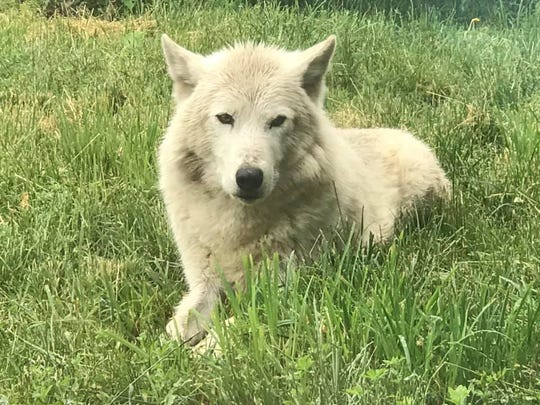Micah Walker, Detroit Free Press
Gray wolves, endangered since the 1970s, are no longer considered at risk of extinction.
According to a news release from the Michigan United Conservation Clubs, the United States Fish and Wildlife Service have created a proposal to de-list gray wolves from the list of endangered and threatened wildlife in the lower 48 states and Mexico earlier this year. The public comment period for the purposed rule began March 15 and will end Monday.
The news comes after the agency began planning a proposal last year.
Gray wolves are prevalent in the Upper Peninsula and on Isle Royale off Lake Superior. MUCC said with the federal agency’s rehabilitation efforts, the state wolf population has exceeded expectations. The USFWS recovery plan for the region required a population of more than 200 wolves for five consecutive years in order for the species to be taken off the endangered list. In Michigan, the wolf population has reached more than 600 in a longer period than the five years.

Wazi the gray wolf is photographed at the Detroit Zoo in 2018. (Photo: Humberto Alzamora)
Here is more information on gray wolves, how they became endangered and how the species rebounded from extinction:
What is a gray wolf?
The largest members of the dog family, gray wolves, or Canis Lupus, are the most common of the species and were once found all over the Northern Species, said National Geographic. Wolves can weigh from 40 pounds to 175, and its size is relative to a 6 foot-tall man. The size of its head and body is usually between 36-63 inches and their tails can grow from a range of 13-20 inches. The average life span of a wolf is 6-8 years.
More: Gray wolf on Isle Royale relocated from Canada found dead
More: Detroit Zoo’s beloved gray wolf dies from cardiac arrest
Do gray wolves attack humans?
No, the wolves do not prey on humans. They mostly focus on larger animals, such as elk, moose and deer. However, they can also eat smaller mammals, fish, birds, snakes and domestic animals.
Where can you find a gray wolf?
According to USFWS, gray wolves were eliminated throughout much of the country by the middle of the 20th century due to hunting. Wolves from Canada occasionally traveled south and began recolonizing in northwest Montana in 1986. In 1995 and 1996, 66 wolves from southwestern Canada were allowed into Yellowstone National Park and central Idaho.
In recent years, most wolf packs congregate in the Great Lakes area or around the northern Rocky Mountains. The wolf population in the states of Michigan, Wisconsin and Minnesota is about 4,400, while Montana, Wyoming, Idaho and parts of Utah, Oregon and Washington are seeing about 1,700 wolves.
How did gray wolves get on the endangered species list?
The battle between wolves and humans began back in the 1800s when European settlers brought their livestock with them to the United States. According to PBS, wolves saw animals, such as cattle, horses, sheeps and pigs as prey, and began hunting them for their next meal. Farmers and private landowners then started to bait and trap wolves, turning the practice into both a sport and protection for their animals.
At Yellowstone National Park in Wyoming, wolf hunting and baiting had turned into a profitable career. In other areas of the southwest where cattle ranching was popular, ranchers hired bounty hunters and professional wolfers to stop pack from attacking their livestock. According to a report from USFWS, government agencies and ranchers began an eradication campaign, where wolves were trapped, shot, hunted with dogs and dug from their dens. In addition, poisoned animal carcasses were left for wolves to find. The bounty programs began in the 19th century and lasted as late as 1965.
Federal protections were first put in place in 1967 for two other subspecies of wolves, the red wolf and the eastern timber wolf, said USFWS. The endangered species list was published under the Endangered Species Preservation Act of 1966, which was the first peice of legislation that allowed wildlife and fish to be protected under federal law.
In 1978, gray wolves were added to the list as an endangered population in the United States and Mexico. However, Minnesota packs were an exception, as the wolf population increased to more than 1,000 during this time.
How are gray wolves being recovered?
The USFWS has partnered with several states, conservation organizations, Native American tribes and private landowners to protect gray wolves since they were added to the endangered species list.
In Michigan, gray wolves has seen a population increase from only 3 during the 1988-1989 survey year to 662 in 2017-2018. In Wisconsin, wolf populations are close to 1,000, with Minnesota still having the largest amount of wolves with more than 2,500 in recent years.
Why might gray wolves be de-listed?
For de-listing to happen, the Endangered Species Act does not require wolves to be present throughout all of its former territories, or for populations to be where they once were. The USFWS created a proposal because, given the rebound in population, it no longer sees gray wolves of being in danger of extinction in the near future.
Source: https://www.freep.com/story/news/local/michigan/2019/07/12/gray-wolves-michigan/1626764001/
